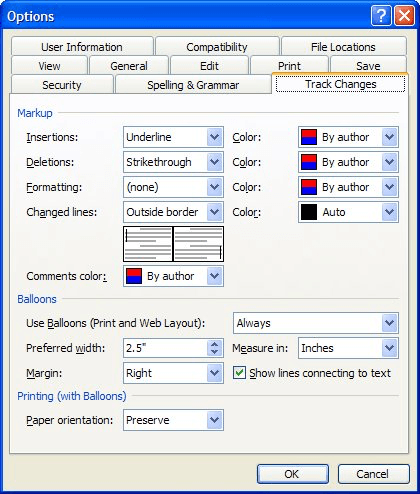Please Note: This article is written for users of the following Microsoft Word versions: 97, 2000, 2002, and 2003. If you are using a later version (Word 2007 or later), this tip may not work for you. For a version of this tip written specifically for later versions of Word, click here: Hiding Formatting Changes in Track Changes.
Written by Allen Wyatt (last updated September 6, 2025)
This tip applies to Word 97, 2000, 2002, and 2003
Bob uses Track Changes quite a bit in his documents and finds it very useful—except for one thing. Bob finds it very distracting that formatting changes are called-out in the changes list. He wonders if there is a way to have Word not call out the formatting changes and only include all other types of changes, and to have this approach be the default for Track Changes.
There are actually a couple of ways you can approach this issue. First, when you turn on Track Changes, Word displays the Reviewing toolbar. You can control what changes Word displays on the screen by using the Show drop-down list. When you display the Show drop-down list, make sure that there is no check mark next to Formatting. With this option turned off, Word still tracks formatting changes behind-the-scenes, but it doesn't display those changes.
If you'd rather that Word didn't even keep track of formatting changes at all, then you can follow these steps:

Figure 1. The Track Changes tab of the Options dialog box.
These steps are "sticky," meaning that you only need to do them once. Word remembers your choice and won't keep track of formatting changes in the future.
WordTips is your source for cost-effective Microsoft Word training. (Microsoft Word is the most popular word processing software in the world.) This tip (10685) applies to Microsoft Word 97, 2000, 2002, and 2003. You can find a version of this tip for the ribbon interface of Word (Word 2007 and later) here: Hiding Formatting Changes in Track Changes.

Learning Made Easy! Quickly teach yourself how to format, publish, and share your content using Word 2021 or Microsoft 365. With Step by Step, you set the pace, building and practicing the skills you need, just when you need them! Check out Microsoft Word Step by Step today!
Track Changes is a great tool to use so that you can, well, "track" what changes are made during the development of a ...
Discover MoreIf you are editing a document with Track Changes turned on, Word won't let you delete a column in a table and have it ...
Discover MoreTrack Changes is a great tool for developing documents. If you want to copy text from one document to another, with ...
Discover MoreFREE SERVICE: Get tips like this every week in WordTips, a free productivity newsletter. Enter your address and click "Subscribe."
There are currently no comments for this tip. (Be the first to leave your comment—just use the simple form above!)
Got a version of Word that uses the menu interface (Word 97, Word 2000, Word 2002, or Word 2003)? This site is for you! If you use a later version of Word, visit our WordTips site focusing on the ribbon interface.
Visit the WordTips channel on YouTube
FREE SERVICE: Get tips like this every week in WordTips, a free productivity newsletter. Enter your address and click "Subscribe."
Copyright © 2025 Sharon Parq Associates, Inc.
Comments